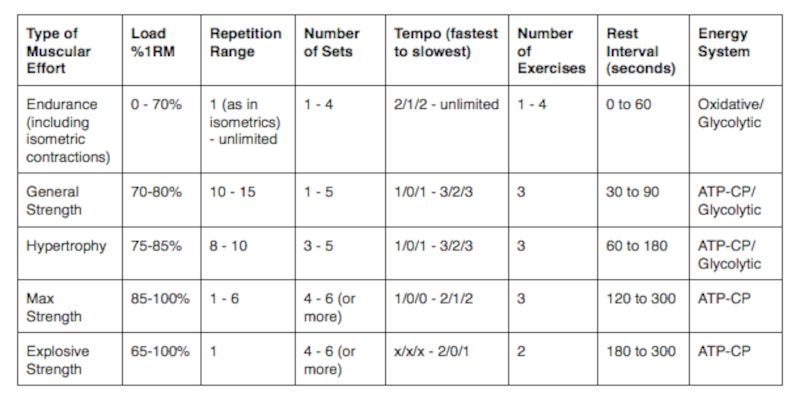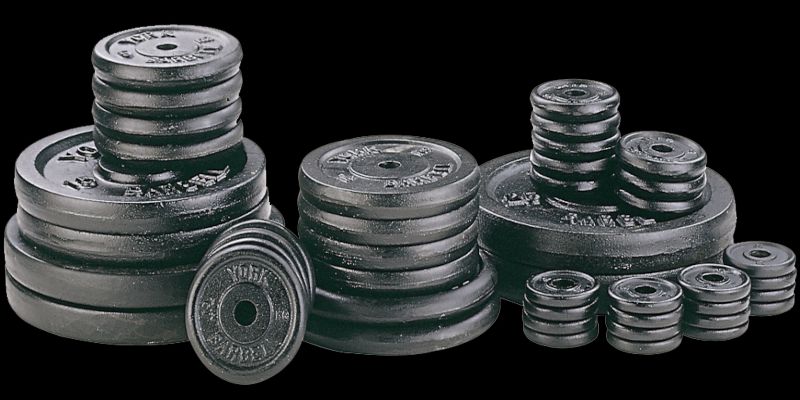Table of Contents
ToggleWorkout guidelines:
Workout time:
Workouts per week:
Rest time between sets:
Training level:
Exercises performed:
Equipment:
Program goal:
40–90 minutes. Dependable on which day of training.
3
3–5 minutes
Intermediate
Squat, deadlift, barbell row, bench press, military press, dips, pulldowns, sit-ups
Barbell, dumbbells, bench rack, squat rack
Strength
The strength training program
Week 1: Workout A
Monday: Volume day
85-90% of 5 rep max
Main lifts
- 3×5 Squats
- 1×5 Deadlifts
- 3×5 Bench press
- 3×5 Barbell rows/rows
Accessory work
- 30-50x Dips, pulldowns, single leg exercise
- 1x… Sit-ups
Wednesday: Recovery day
70% of 5 rep max
Main lifts
- 3×5 Deadlifts
- 3×5 Military press
Accessory work
- 30-50x Dips, pulldowns, single leg exercise
- 1x… Sit-ups
Friday: Intensity day
100% of 5 rep max
Main lifts
- 1×5 Squats
- 1×5 Bench press
- 1×5 Barbell rows/rows
Accessory work
- 30-50x Dips, pulldowns, single leg exercise
- 1x… Sit-ups
Week 2: Workout B
Monday: Volume day
85-90% of 5 rep max
Main lifts
- 3×5 Deadlifts
- 1×5 Squats
- 3×5 Military press
- 3×5 Barbell rows/rows
Accessory work
- 30-50x Dips, pulldowns, single leg exercise
- 1x… Sit-ups
Wednesday: Recovery day
70% of 5 rep max
Main lifts
- 3×5 Squats
- 3×5 Bench press
Accessory work
- 30-50x Dips, pulldowns, single leg exercise
- 1x… Sit-ups
Friday: Intensity day
100% of 5 rep max
Main lifts
- 1×5 Deadlifts
- 1×5 Military press
- 1×5 Barbell rows/rows
Accessory work
- 30-50x Dips, pulldowns, single leg exercise
- 1x… Sit-ups
The strength training program explained

Alternating between the workouts
The layout of the strength training program is simple and intuitive.
You keep rotating between workouts from the first two weeks.
This means you start with the workout program from week 1 (A on Monday, B on Wednesday, A on Friday) The next week you take the workout program from week 2 (B on Monday, A on Wednesday, B on Friday). Then you switch back over to the workout program from week 1 (A, B, A) and so on.
So basically you keep alternating between those two weeks.
Amount of reps and sets explained

How many reps, sets you perform how long you rest, and how heavy you lift all depend on your training goal. Indicating that there’s no single best rep range. You will be performing at least 2 warm-up sets and 3 working sets for each main lift every workout. This means that the accessory work is excluded from performing 2 warm-up sets and 3 working sets, seeing as you are already warmed up when you get to the accessory work.
The weight of your warm-up sets doesn’t matter that much, as the purpose of those 2 warm-up sets is to get your body and muscles warmed up while gradually increasing the weight being lifted. For example, if you’ll be performing your bench press working sets with 100 kg then your warm-up sets might be something like 40 kg for the first warm-up set and 60 kg for your second warm-up set.
Your working sets mean that those sets are your real training weight and, thus, feel heavier. It is those sets that will drive your strength to progress, so you’ve got to make them count. Your 3 working sets with for example bench press will be performed with the same weight for that specific exercise. If we reuse the previous example, then our 3 working sets for bench press would be performed with 100 kg.
You’ll be performing between 30–50 reps of accessory work each training session, although it is not mandatory, it is recommended because it increases the training capacity and muscle gains.
How many of those reps you perform is up to you. Note that it is accessory work for a reason. The goal is to get some more reps in and work on some weaknesses, not to lift heavy weights. Your working sets of the main program should be heavy work, and your accessory work should not interfere with your recovery.
So keep the weight of your accessory work low.
How long should you rest in between sets?

Your warm-up sets should be performed with relatively light weights, so in general little amount of rest is required. Between 1–3 minutes should be more than enough.
For your working sets, you should take about 3–5 minutes to recover enough strength for your next working set.
If you need longer than 3–5 minutes of rest to complete your next working set, then it means you are lifting too heavy or that your recovery is not on point. If your recovery is not on point, try to sleep and/or eat more.
If 3–5 minutes of rest in between working sets is not enough, lower the weight a bit and see if you recover faster.
Although not necessary, I would recommend supersetting your accessory work. This means performing multiple different exercises one after another without any rest in between.
For example: 10 dips, 10 pull downs, and 10 single leg reps without any rest in between those exercises. After supersetting multiple exercises, take between 1–2 minutes of rest and superset those same exercises again until you hit the prescribed amount of reps.
How much weight should you lift before starting the intermediate strength training program?

The starting position of a bench press. Strength levels will vary from person to person. It also depends on if you finished a strength training program tailored to beginners. If you did, then your strength will be pretty decent, and you’ll have a solid base to build on.
It is also possible to start with this type of programming, rather than doing a program with linear progression first. However, I would not recommend it since beginners will always be able to get stronger more quickly following a strength training program that’s based on linear progression, aka Adding weight every workout session.
Exemplary lifting stats of someone looking to switch to an intermediate training program might look like the following. Take note that the following numbers are only there as a guideline, not e requirement.
Squat: 1×100-140 kg.
Deadlift 1×120-150 kg.
Bench press 1×80-100 kg.
Military press 1×50-60 kg.
Barbell rows 1×80-100 kg.Note that those numbers are just an example of what weights you might be lifting before starting off the intermediate strength training program.
Those numbers will vary from person to person based on how much you weigh, how strong you naturally are, and if/how long you’ve been following a strength training program for beginners.
How much weight to add to each workout

Since we are intermediate strength athletes now, our previous linear form of periodization which was perfect for beginners is no longer possible.
This means we can no longer add weight to the bar every workout. To continue progressing, we must formulate a new, advanced way to continue adding weight to the bar. We will do this in the form of non-linear progression.
That’s the biggest difference in this program compared to my strength training program for beginners. The non-linear form of periodization. This means that the amount of sets, reps, and weight being added to the bar is not constant and will vary from workout to workout.
Instead of adding weight to the bar every workout to get stronger, we’ll try to hit a new 5-rep max each Friday. Based on this new 5 rep max, our volume days on Mondays and recovery days on Wednesdays are calculated. So instead of the linear progression from workout to workout from the novice strength training program, we’ll be switching to a non-linear, weekly progression.
Since we are no longer beginners, our strength gains will slow down. This is why I recommend trying to add between 1-2 kg to the bar weekly.
What is deloading and when should you do it

If you find yourself unable to add weight to the bar and hit the preset amount of reps, then you should try again your next workout with the weight you failed your lift at.
If you fail to hit the preset amount of reps of the same lift 3x in a row, then it means your progression on that lift has halted, and your best bet is to deload. Some people program a fixed deload week in their training program to give their body some time off to recover.
I would generally recommend downloading for 10% of your maximum training weight for the lift you are deloading on. For instance, if 100 kg is your maximum training weight, deload it to 90 kg and try adding 2 kg or even 1 kg every workout again, so your body has time to adjust. I recommend resting for 3 minutes between each set, so your muscles get time to recover, and you can lift heavy again.
If you deloaded and eventually start failing at that lift again, then you have two possible options. Option one is to deload again by about 10%. Option two is starting to perform 3 reps instead of the usual 5 reps. When your progression comes to a halt on 3 reps, switch to heavy singles. (Singles as in single reps, not your sexual status…)
You will eventually have to switch to triples and singles because your training weight will become too heavy for your body to adequately recover between workout sessions. Lowering the amount of reps means the overall lifting volume lowers, which will in turn place less stress on the body.
If you’ve deloaded at least once, do your triples and eventually your heavy single reps, and you start to stall again, then it’s time to switch to an intermediate strength training program which is a more specialized training program with non-linear periodization.
The goal of this workout program

The goal of this workout program is primarily increasing strength.
Perfecting technique
Perfecting the technique is also something we should continue to strive for. Your work capacity and anaerobic endurance will continue to improve as well thanks to your accessory work.
While not necessarily the main goal of this strength training program, you will gain muscle mass as long as you eat enough calories and consume enough proteins. Your accessory work adds volume to the training program, which is generally needed to increase muscle mass.
If this program is too challenging, or you feel like you’re not ready for an intermediate strength training program, then this strength training program for beginners might suit you instead.
Why does this workout program work?

Heavy compound exercises
Your main lifts are heavy compound exercises. Compound exercises are exercises that hit multiple muscle groups at once.
These exercises give you the most “bang for your buck” so to speak. Not only are those exercises less time-consuming, but the fact that they recruit multiple muscle groups at the same time means that you can lift heavier weights as well. This will lead to more and faster strength gains.
Squatting and deadlifting mostly work the various leg muscles while also working out our core as our core needs to stabilize the weight. Deadlifting has the additional advantage of working out the lower back. Barbell rows work out the back muscles, mainly the upper back.
Bench pressing mainly works out the chest muscles while having the additional benefit that it also works out the triceps muscles. The military press mainly works out the shoulder muscles (deltoideus, and in particular the anterior head.)

Your main lifts are the lifts which are the most important and where you should focus on the most. Those are the exercises where we will try to add weight every workout to get strong as quickly as possible. Remember, though, you should never sacrifice good form while lifting. If your form is off then you are probably lifting too heavy, or you have not yet mastered the basics of the lift aka: bad technique.
The accessory exercises are in the program to build up work capacity and to get some more reps in to stimulate muscle growth, seeing as muscle size is also a factor in strength. Accessory work is not necessary to become strong. However, if you do choose to do the accessory work, then do so with a relatively lightweight in order not to hinder your recovery. It’s possible to superset your accessory work to reduce the time you need to be in the gym.
So accessory work should be done quickly and with lightweight
Non-linear progression
Non-linear progression is one of the most efficient ways for intermediate lifters to continue increasing their strength.
Since linear progression is no longer possible, non-linear progression becomes a must to keep getting stronger.
Why and when should you follow the intermediate strength training program?

This strength training program is designed specifically for intermediate lifters.
I would recommend starting this program when linear progression on this strength training program for beginners or any strength training program that’s geared towards beginners is no longer possible.
Not being a novice lifter anymore means that it’s no longer possible to add weight to every workout, even after you tried to deload to break through this strength plateau. Thus, you must switch to a more advanced strength training program with more advanced programming.

This will eventually happen to all of us if we lift long and heavy enough. With this intermediate strength training program, you will still be performing full-body workouts. It will however teach you valuable and more complex skills like programming, deloading, non-linear progression, and most importantly, varying training intensity to recover adequately. These skills are all vital for making progress as an intermediate lifter.
The biggest difference in this intermediate strength training program compared to my beginner strength training program is the non-linear form of periodization. This means that the amount of sets, reps, and weight being added is not constant and will vary from workout to workout. Instead of adding weight to the bar every workout to get stronger, we’ll try to hit a new 5-rep max each Friday. Our volume days on Mondays and recovery days on Wednesdays are calculated based on our hopefully new weekly 5 rep max.
Conclusion

If you want a clear-cut and enjoyable intermediate strength training without too much fancy stuff, then this training program might just be the right fit for you.
It’s a little more advanced in the way of programming compared to most strength training programs because of the non-linear way of progression. However, this is not too hard to figure out and is necessary to keep progressing in strength as an intermediate lifter.
Just make sure to note that this is primarily a strength building and not a bodybuilding program. If muscle gain is your main goal, then I wouldn’t recommend following this program. Even though you will most likely gain some muscle mass.







1 thought on “Intermediate strength training program”
Comments are closed.